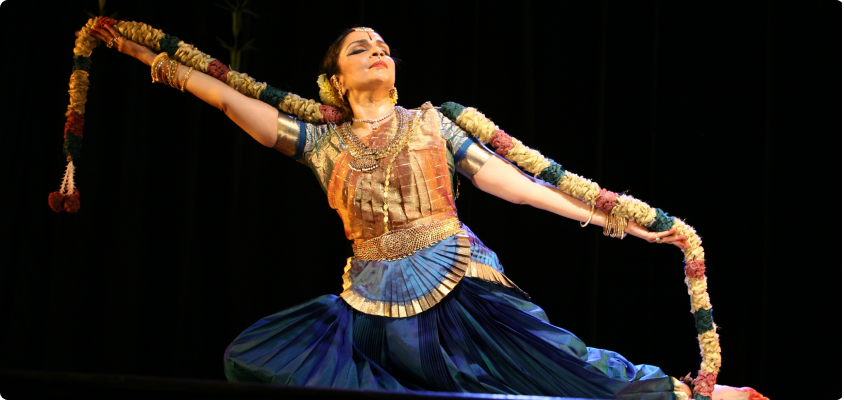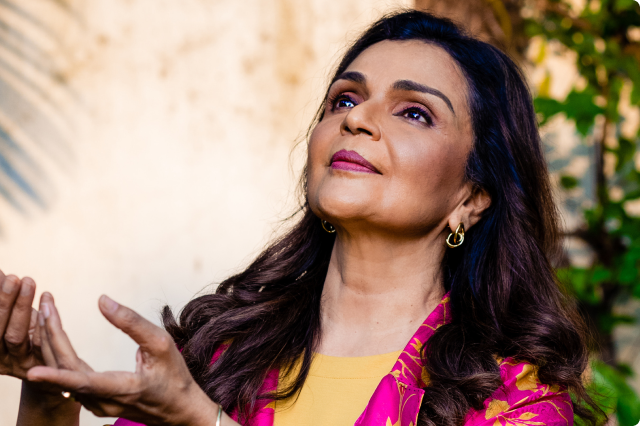"We need to embrace both tradition and modernity, and create a space where they can coexist."
Traditions and heritage are an important part of Dr. Anita Ratnam's artistic inquiry. Forms like Bharatanatyam, Mohiniyattam, Kathakali and Yoga that Anita has learned over the years, have seen a modern reconstruction without which it would have been difficult to produce an assimilated response to the forms. As a performing artist Dr. Anita Ratnam felt drawn to work on preserving and reviving traditions that were dying or had low visibility. As part of her Ph. D. thesis, Anita set out to revive Kaisiki Natakam, a dying theatrical ritual practice found in the temple at Tirukurungudi, a town in the Tirunelveli district, Tamilnadu. She is also one of the few female practitioners of Arayer Sevai that is now sadly practiced in only a handful of temples. The ritual performance uses chanting and gesticulation before an idol of the god Vishnu. Another project that was a collaboration between National Institute for Design (NID) and the Arangham Trust, focussed on reviving various crafts from Tamil Nadu.

Kaisiki Natakam:
Ritual is part of life, and Kaisiki Natakam, a rare living theatrical ritual found in the temple town Tirukurungudi, finds itself woven into the social fabric. After having fasted all day while observing Ekadasi, (the 11th lunar day in the Tamil lunar calendar), the performers and devotees break their fast only after watching the 4 hour-long performance and offering their prayers before sunrise, the form remains inseparable from tradition. Such was the history of Kaisiki Natakam from the 15th century till the India's independence. By the 1950s, the ritual performance was almost entirely forgotten. After the last performance in 1955, temple artistes could not sustain the art in its original state, they were already disenfranchised due to the political Devadasi act of 1947 which disallowed hereditary artistes from performing in temples. It did not help that young independent India had new priorities and was focussed on first generation nation building, which took the energy away from sustaining Kaisiki Natakam and other hereditary art forms.
The original purpose of the script and the performance was to keep the devotees awake all night despite having fasted throughout the previous day. However, by the time the revival project had begun, only a few faint traces of its script could be found. When she attended a performance of Kasiki Natakam in 1996, Anita found the form in a decrepit state, with 3 performers on stage reading from pieces of paper attended by dozing temple administration. Anita had to begin reconstructing the script based on the memory and accounts of village elders in Tirukurungudi. The work led her on a search for the palm leaf manuscript, which needed transcribing, deciphering the notations and the suggested musical structure, and reconstructing and reimagining the performance by observing the sculptures on the temple walls. She spent 3 years rebuilding the form brick-by-brick and finally presented a revived Kaisiki Natakam performance in November 1999. If not for her intervention about two decades ago, the ritual performance may have been all but lost. Going forward Anita says that she has no plans of bringing Kaisiki Natakam into the proscenium as she believes that it should be viewed only in the environs of Vishnu temples.
Arayer Sevai:
Monuments crumble, manuscripts get moth eaten and traditional fine arts practised for centuries in temples are being forgotten because of long years of neglect. Thanks to Dr. Anita Ratnam, Arayer Sevai, a visual enactment of the passionate expression by Vaishnavite saints which were an integral part of Vishnu worship 1000 years ago, is no longer confined to a handful of practitioners who are on the threshold of fading away. Anita was involved in a five year project - initially supported by a senior fellowship from the Government of India which she continued with personal resources - to research the performance ritual of Arayer Sevai and trace its links to modern day Bharatanatyam in the areas of religion, theology, social studies, performance and faith. Who were the Arayers? What makes this dramatic form so unusual in the landscape of Indian performance, ritual, religion and theology?
Dr. Anita Ratnam is a pioneer in the revival and promotion of the ancient temple art form Arayer Sevai. Her contributions to the art form have not only brought it back to the spotlight but have also contributed to its preservation and evolution for contemporary audiences. Having learned the art form from traditional practitioners in Tamil Nadu, including the late K.P. Kittappa Pillai, a renowned Araiyaar, Dr. Anita Ratnam has a deep understanding of the history, mythology, and performance aspects of Arayer Sevai. Her research and extensive experience performing in temple festivals, including the annual festival at the Chidambaram temple in Tamil Nadu, have enabled her to offer authentic and innovative interpretations of the art form. Anita has also integrated elements of Arayer Sevai into her contemporary dance productions, infusing the ancient tradition with modern sensibilities.Shiva.
Narthaki like its founder, continues to grow in response to the possibilities of the internet. “Neo Narthaki” comes as a young and fresh offering from the Narthaki family that was launched in August 2020, and is aimed at younger dancers and creative practitioners. The platform brings politics, economics, history, health, lifestyle and gender into the conversation about dance; and aims to stimulate and encourage a new generation to engage via social media, to speak, discuss, share, perform and create a more equitable and open space where art and art-making is the central focus, with dance as the fulcrum.
In the late eighties when dancers all over the world struggled to be connected and to access resources, Narthaki appeared as a treasure in the form of a simple telephone directory of 1000 artistes and resource people. The idea took shape when the American Broadcasting Company couldn't reach dancer Yamini Krishnamurthy, and Anita helped source her number. Back then it was the only worldwide directory which was consistently updated by Dr. Anita Ratnam and her team. The first edition was published in 1992 and was considered the 'Bible' of Indian dance. The second edition in 1997 was welcomed for the continuity it provided. After it went online on 14 April 2000, the response from the dancers was overwhelming because they unanimously said that Narthaki had democratised dance.
From a directory to a resource portal to being a producer and curator of original dance content, Narthaki has come a long way. 30 years after its conception, Narthaki is a one-of-its-kind networking tool for the dance community. It features a comprehensive Address Bank of practitioners and teachers of Indian classical dances worldwide, the contact details for musicians, festivals, and dance spaces. Narthaki bypasses the nepotism and gatekeeping that one might encounter in the industry and helps dancers and dance-makers get right down to business and even offer more reach for their digital presence. It features performance listings, previews, reviews & reports of performances, profiles of dance legends, interviews, articles, research papers, dance films, and even obituaries. Some of the special columns by eminent writers and scholars include “Taalam” by Leela Venkataraman, “Eastern Eye” by Dr. Utpal K Banerjee, “Soch” by Dr. Arshiya Sethi, “Dance Matters” by Ashish Mohan Khokar, and “Choreographing Between Two Worlds” by Janaki Patrik. The highlight of Narthaki is the carefully crafted monthly editorial by Dr. Anita Ratnam and the newsletter that goes out on the first of every month.
When the pandemic hit India in March 2020, Narthaki became a beacon that kept the fire of creative passion alive for dancers the world over. The first of the pandemic series to be launched on the Narthaki Youtube channel was 'Boxed', a series of two-minute dance films made by contemporary and classical dancers across the world, that examined what it felt like to be locked-down and isolated. 'Boxed' went on to generate another video series called 'Taalam Talkies' - that looks at classical dance in South Indian cinema by profiling renowned Bharatanatyam dancers who have had a strong presence on the silver screen. Narthaki also launched 'Devi Diaries' - a celebration of the feminine and divine - 'Andal's Garden', a series of curated performances celebrating the spirit and poetry of Andal, as well as 'A-Nidra' a series launched during Shivaratri in celebration of Lord Shiva.
